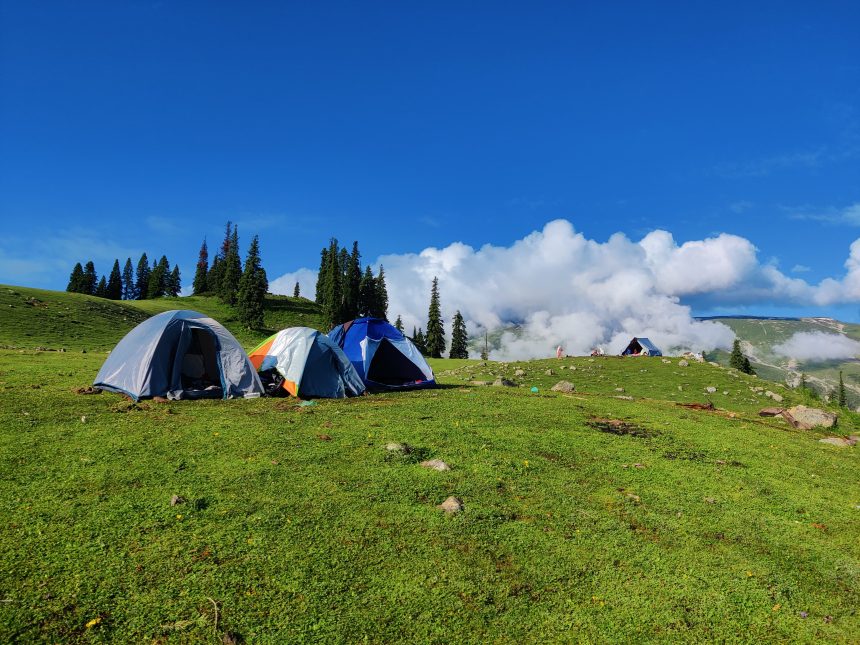The upper reaches of South Kashmir’s Pulwama district, nestled within the Shopian Forest Division, are home to several largely unexplored but enchanting places that offer endless opportunities for trekking, adventure, and camping.
Among these hidden gems is Shidak, a serene hill station located in the lap of the Pir Panjal mountains, offering visitors breathtaking panoramic views of the Kashmir Valley.Shidak, perched at an elevation of approximately 13,500 feet above sea level, is a destination that promises tranquility and natural beauty.
Situated between Dubjan and Yusmarg, Shidak is surrounded by lush green pastures and towering pine trees, creating a pristine environment for nature lovers and trekkers.
One of the most significant attractions of Shidak is the shrine of Sufi Saint Janbaaz Wali Baghdadi, a revered figure whose legacy draws devotees to this remote location.For those embarking on a spiritual journey, a mud hut has been constructed at Shidak, providing temporary shelter to devotees who come to pay their respects at the shrine.
Adding to the charm of this secluded spot is a hot water spring, believed to possess medicinal properties that can heal various ailments. This spring, the only water source in the area, further enhances the mystical allure of Shidak.Reaching Shidak is an adventure in itself.
The hill station is located approximately 35 kilometers from Pulwama’s district headquarters and can be accessed via multiple routes, each offering a unique experience. The journey typically begins at Namblan, a serene and unspoiled bowl-shaped valley that serves as the base camp for the trek to Shidak.
Namblan is accessible via the Pulwama-Abhama or Newa-Pakherpora road, with the motorable route ending at Kandpathri, a locality in Sangerwani. From Kandpathri, travelers embark on a path that leads to an elevation, offering a sweeping view of the mesmerizing landscape below. After parking their vehicles at a small patch of land, visitors descend the elevation and cross the Romeshi rivulet by walking over wooden logs. The adventure continues with a 30-minute trek through steep, beautiful green pastures, eventually leading to Namblan.
Namblan itself is a destination worth exploring. The valley is dotted with scattered huts made of wooden logs and mud, which are used by the nomadic Gujjars and Bakerwals during the summer months for grazing their cattle. These traditional dwellings, known as “dokhis,” are adorned with beautiful hand paintings, adding to the cultural richness of the area.The simplicity and purity of life in Namblan transport visitors back in time, offering a glimpse of Kashmir’s yesteryears.
The Gujjars and Bakerwals lead a simple but fulfilling life, relying on the resources provided by the surrounding forests. The women of the community rear traditional varieties of chicken and knit handmade skull caps, maintaining their cultural heritage.
Another route to explore this pristine region is via Sangam, a small pasture where two streams from the Pir Panjal mountains converge to form the Romeshi river. Sangam is an ideal halting point for trekkers to rest and enjoy a meal by the bubbling stream. However, visitors must be cautious of the monkeys that inhabit the area in large numbers. Sangam itself is divided into two parts: Chotti Sangam and Badi Sangam, each offering its own unique charm.
Further along the trek lies Dhanzaban, a mesmerizing pasture set against the backdrop of Gager Rayil. Dhanzaban is slightly marshy and comparatively larger, with large rocks scattered throughout the pastures, providing natural seating for visitors to rest and rejuvenate after a walk.
Bargah, another meadowy pasture in the area, is used for grazing sheep by the shepherd community from Charipora village in Budgam. Bargah, like the other pastures in the region, offers a serene and untouched environment for visitors to immerse themselves in nature.








